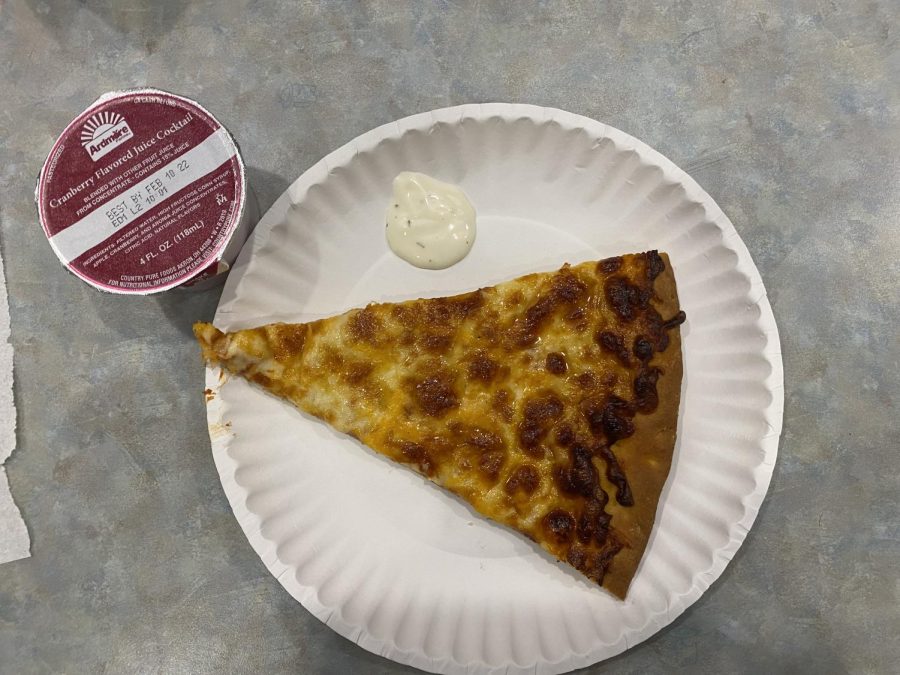Food for Thought: WHS Cafeteria Needs to Provide More Choice for Students with Different Dietary Plans
December 9, 2021
Since I’ve been at WHS, the school lunch experience has not been the best.
Imagine this. You walk out of your class, tired and ravenous after several hours in a classroom, excited to see what options there might be that day. You quickly make your way down the winding staircase, dropping your heavy bag, and heading down to the cafeteria. You sigh, grateful that you got there early enough to not be stuck in a line and then go through the doorway to the food.
The first thing you see are containers of salads and wraps, but almost all of them include some sort of meat. You move on, pitying the other students that might have food restrictions but who are looking for something light. You then stop at the pizza trays, seeing that there are both pepperoni and cheese varieties and the occasional special pizza. You pick up a flimsy paper plate and scoop one pizza slice, your allotted amount, and while walking to the lunch lady, you pass by the burger section. While making your way out, you note that the cafeteria usually only serves chicken or cheeseburger patties, and not any for anyone with dietary limitations.
But you move on, show the lunch lady your meal, and you walk right past the select few condiment packets and the large milk storage. As you walk out of the cafeteria, you recall the rule about ketchup that your friend mentioned. You couldn’t imagine only being allowed to have 3 little packets of ketchup for the barely seasoned food given. But you take your food and leave.
This is the general experience for anyone who wants WHS “free and reduced lunches” but comes out disappointed with greasy pizza, unseasoned burgers, or bland salads and wraps because there isn’t anything else for you to have. As a vegetarian myself, all the “balanced and nutritious meals” at WHS get reduced down to a slice of cheese pizza, ranch, and juice.
Now I get it. Because of Covid, free lunches are much easier for families and accessible. It’s good. But my problem is why make it free if it isn’t sustainable. Making it free means that more people are going to have it. That’s just a given. But, it’s counterproductive if you change something to make more people want it but make the actual food worse. You help no one if you offer them free school lunch to help them but send them home with an unhealthy and underfed stomach.
Speaking of underfed stomachs. A few weeks ago, I was craving a banana muffin after finishing my slice of cheese pizza. My friend had asked for a juice, and because of the unofficially-official “One muffin and a juice, fruit, or milk” rule during snack, it worked out and I had agreed. I walked up to the counter and requested one muffin and one juice, making sure not to touch them because of the rule that “you cannot touch the food, I will only hand it to you.” (The rule never made sense to me because while at first, it might seem to be for covid safety, it wouldn’t be very safe if only one of the lunch lady’s enforced the rule, would it?)
But to my request, she only asked me where my lunch was. I pointed to my seat. She then went on to ask if I had gotten it from the cafeteria. I had simply nodded. At that, she shook her head, quite vehemently if I might add, saying that a muffin is a full meal and that I could not have it.
Now I have second lunch. I understand that food needs to be saved for the next lunch. It makes sense. What doesn’t make sense is why one small banana muffin is a full lunch meal. How can one muffin be an option to sustain a student until their next meal? Because that is what a meal is, right? At least so it says in Medical News Today as it comments on their definition of a balanced meal: “A balanced diet fulfills all of a person’s nutritional needs. Humans need a certain amount of calories and nutrients to stay healthy. A balanced diet provides all the nutrients a person requires, without going over the recommended daily calorie intake.”
But after her answer to my question, in slight disbelief, I asked her about the muffin once more, clarifying if I heard right. I did.
I thought back to the cafeteria at that moment. At the balanced meal signs and the importance of proper nutrition. Of having all the food groups for a meal. Of getting enough energy from all foods to fuel your body.
I took the juice and walked away.
Schools have to feed high school students. They understand the need and importance of healthy meals. Of having fruits, vegetables, grains, dairy, and protein. It’s been ingrained into their brains since elementary school. But they’re going to eat what they feel that they want. At snack, if they are forced to take a fruit or milk with a muffin or rice Krispy, they’re not going to have it. Every day, I see kids receiving their fruit or milk, and once out of the lunch lady’s sight, they toss it in the trash. Nutrition is important. Dairy and fruit are essential. But at what cost?
As teenagers, they learn and know their boundaries regarding food. If they are not going to have it, don’t make them take it. Don’t shove it in their hands and just expect it to be enough for people to have every single day. It just ends up wasting so much fresh fruit and milk.
You might be thinking, “what kids want to have those things?” But people who might be lactose intolerant, or gluten-free, or vegan opt-out of the muffin or gelatin treats, to have a fruit that will fuel them to lunch. I’ve seen it firsthand. And I know many others have as well. Allergies play a part as well. Teens are going to eat poorly whether or not they eat the food groups they are offered or not.
Though eating healthy is important, schools must think realistically here. If expected to act and behave like adults, shouldn’t the same be applied to their food choices? As adults or people who must act like them, high schoolers should be accepted and allowed to choose what they eat. If they want to keep a balanced diet or have a single pepperoni pizza for their lunch, so be it. Nothing is going to change in regards to healthier school lunches if students try to find a way out of it. Like, for example, throwing it away when it is given to them.
But in the matter of the actual lunch meals, there needs to be more variety. Having to get a plain slice of pizza every day over the rare black bean burger is exhausting. Seeing that is it frequently the only hot lunch I can get, compared to my chilled salads and wraps that are offered. Those that often include cheese or some sort of meat product.
And of course, statistically, there are more non-vegetarians than people with food restrictions, but shouldn’t the school still accommodate the people that do have limits?
All in all, no matter what the school determines as a full lunch or what they decide to serve, the free and reduced lunches have been accessible for many and probably a weight lifted from many parents’ conscience after the height of the pandemic in 2020. But though it may be true, school lunches need to change their system to accommodate different students and what they eat daily.
Source Used:
Medical News Today







